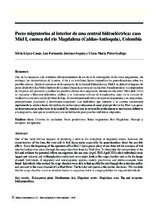Mostrar el registro sencillo del ítem
Peces migratorios al interior de una central hidroeléctrica: caso Miel I, cuenca del río Magdalena (Caldas-Antioquia), Colombia
| dc.creator | López-Casas, Silvia | |
| dc.creator | Jiménez-Segura, Luz Fernanda | |
| dc.creator | Pérez-Gallego, María Clara | |
| dc.date.accessioned | 2016-10-04T11:42:07Z | |
| dc.date.available | 2016-10-04T11:42:07Z | |
| dc.date.issued | 2014-12 | |
| dc.identifier.issn | 0124-5376 | spa |
| dc.identifier.uri | http://hdl.handle.net/20.500.11761/9453 | |
| dc.description | One of the most obvious impacts of damming a river is the disruption of migratory routes, however, the characteristics of the dam, the river and its fish fauna make impossible the generalizations about the possible effects. Since the beginning of the operation of La Miel I hydropower plant, it was detected the entrance of fish into the hydropower plant (through the surge chamber) from La Miel river. To determine the composition of the fish and evaluate the potential effects on migration, for one year (April 2010-April 2011) adult individuals were tagged and released and ichthyoplankton collections were made, both in the surge chamber and in the discharge channel. Individuals of migratory and non-migratory species, mainly piscivorous and detritus-scrapers were found. Individuals who entered the surge chamber were able to find quickly the exit through the restriction orifice and returned to the main channel of La Miel River. The fish did not spawn in the central structures. We conclude that the surge chamber is not an absolute barrier to migration, but it is a staging habitat for migrant individuals. | spa |
| dc.description.abstract | Uno de los impactos más evidentes del represamiento de un río es la interrupción de las rutas migratorias, sin embargo, las características de la presa, el río y su ictiofauna, hacen imposibles las generalizaciones sobre los posibles efectos. Desde el comienzo de la operación de la Central Hidroeléctrica Miel I, se detectó el ingreso de peces desde el río La Miel al interior de la central (hasta la caverna de oscilación). Para determinar la composición de los peces allí presentes y evaluar los posibles efectos en la migración, durante un año (abril 2010-abril 2011) se marcaron y liberaron individuos adultos, y se realizaron colectas de ictioplancton, tanto en la caverna de oscilación como en la salida del túnel de fuga. Se encontraron individuos de especies migratorias y no migratorias, principalmente piscívoros y detritívoros-raspadores. Los individuos que entraron a la caverna encontraron rápidamente la salida a través del orificio de restricción y retornaron al canal principal del río La Miel. Los peces no desovaron en las estructuras de la central. Se concluye que la caverna de oscilación no es una barrera definitiva a la migración, sino que se constituye como un hábitat de paso para los individuos migrantes. | spa |
| dc.format | application/pdf | spa |
| dc.format.extent | 26-39 | spa |
| dc.language.iso | spa | spa |
| dc.publisher | Instituto de Investigación de Recursos Biológicos Alexander von Humboldt | spa |
| dc.relation | Publindex | spa |
| dc.relation.ispartofseries | Año 2014, Vol. 15. núm. 2 | spa |
| dc.source | reponame: Repositorio Institucional de Documentación Científica Humboldt | spa |
| dc.subject | Caverna de oscilación | spa |
| dc.subject | Peces potádromos | spa |
| dc.subject | Rutas migratorias | spa |
| dc.subject | Río Magdalena | spa |
| dc.subject | Marcaje y recaptura | spa |
| dc.subject | Ictioplacton | spa |
| dc.title | Peces migratorios al interior de una central hidroeléctrica: caso Miel I, cuenca del río Magdalena (Caldas-Antioquia), Colombia | spa |
| dc.type | info:eu-repo/semantics/article | spa |
| dc.type.spa | artículo | spa |
| dc.identifier.doi | http://10.21068/c0001 | spa |
| dc.rights.accessRights | info:eu-repo/semantics/openAccess | spa |
| dc.type.hasVersion | info:eu-repo/semantics/acceptedVersion | spa |
| dc.publisher.edition | Regular | spa |
| dc.subject.subjectenglish | Hidropower plant | spa |
| dc.subject.subjectenglish | Potadromus fish | spa |
| dc.subject.subjectenglish | Migratory routes | spa |
| dc.subject.subjectenglish | Magdalena river | spa |
| dc.subject.subjectenglish | Tag and recapture | spa |
| dc.subject.subjectenglish | Ichthyoplankton | spa |



